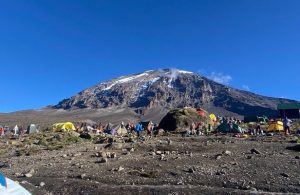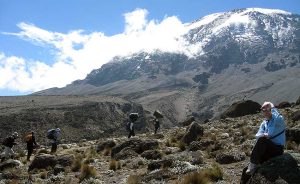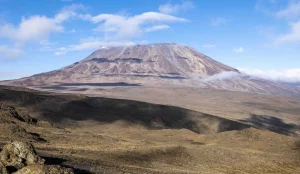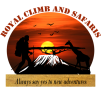Kilimanjaro National Park Day Trip – Shira Plateau
Get active and hike on the slopes of Mt Kilimanjaro on this day trip. If you don’t have time to join a Kilimanjaro climb, you can enjoy views of the highest mountain in Africa on this one day hike on the Shira Plateau.
Itinerary
Day 1 Arusha – Kilimanjaro National Park/Shira Plateau – Arusha
Early in the morning of your Kilimanjaro day trip, we will pick you up at your hotel – an active day in Tanzania’s wilderness area awaits. The drive to your destination of West Kilimanjaro takes you through a forest reserve, where you can look out for Colobus Monkeys in the trees. Your hike through the beautifully rugged landscape of Shira Plateau starts at 3,500 m above sea level. Get out of the car, lace up your shoes and take in the sounds, smells, and colours of Tanzania’s stunning wilderness. Along different trails and accompanied by a ranger, you can enjoy views of Kibo, Kilimanjaro’s highest peak, and its northern glaciers, when the weather permits. The vast plains of neighbouring Amboseli National Park in Kenya and the deep gorge of the Simba River contrast the views of the world’s highest free-standing mountain. When you reach the northern rim of Shira Crater, take a quick stop at different observation points and see the volcanic cones dotting the landscape below. Hike at your own pace and enjoy a picnic lunch under the open sky along the way. It’s a moderate hike and you don’t need to be an athlete to be able to enjoy it. However, at 3,500m the air is thinner, so pace your step, enjoy the untouched landscapes and the presence of the mighty Kilimanjaro. After a 4h hike – or earlier, if your legs get tired – we take you back to your hotel.
You don’t need hiking boots for this Kilimanjaro day trip. However, we recommend closed shoes such as trainers.
Inclusions
- Transportation: Comfortable 4×4 Land Cruiser
- professional, English-speaking guide or ranger
- meals according to the itinerary
- drinking water
- all national park and guiding fees
Not Included
- International Flight
- Accommodation in Arusha:Hotel stays before and after the safari are not included; you may arrange these separately.
- Airport Transfers:Pick-up and drop-off services at Kilimanjaro International Airport are not included; these can be organized upon request.
- Tips:Gratuities for the driver/guide.
Price = 1 person USD 520 per person , 2 – 4 person USD 380 per person, 5-7 person USD 300 per person
What to Expect During Safaris
Wildlife Viewing: You’ll have opportunities to see a wide variety of animals in their natural habitats, including lions, elephants, giraffes, zebras, and many more.
Game Drives: Most safaris include guided game drives in comfortable 4×4 vehicles, allowing for close-up views of wildlife.
Professional Guides: Knowledgeable guides will provide insights into animal behaviors, ecosystems, and local cultures.
Scenic Landscapes: Expect to see stunning vistas, from rolling savannas to lush forests, and unique geological formations.
Cultural Experiences: Some safaris include visits to local communities, where you can learn about their traditions and lifestyles.
Best Time to Visit
Dry Season (June to October): This is the peak time for wildlife viewing, as animals congregate around water sources. The weather is generally warm and dry.
Calving Season (January to March): Ideal for witnessing the birth of wildebeest calves in the Serengeti, attracting predators.
Green Season (November to April): While wildlife is still visible, the landscapes are lush and green, making it perfect for birdwatching, though some areas might be less accessible due to rain.
Accommodation Options During Safaris
- Mid-Range Accommodation: Comfortable lodges or tented camps with en-suite bathrooms, dining facilities, and a cozy atmosphere.
- Luxury Accommodation: Upscale lodges and luxury tented camps with premium amenities, gourmet dining, and personalized service.
Clothing Recommendations
- Lightweight Clothing: Opt for breathable, moisture-wicking fabrics to keep you cool and comfortable during the day.
- Neutral Colors: Wear earth tones like khaki, green, and brown to blend in with the environment and not scare off wildlife.
- Layering Options: Bring layers to adjust to varying temperatures, especially during cooler mornings and evenings.
- Comfortable Footwear: Sturdy walking shoes or hiking boots are essential for game drives and walking safaris.
- Accessories: Don’t forget a hat, sunglasses, and a light scarf or shawl for sun protection.
- Camera Tips
- Camera Type: A DSLR or mirrorless camera with a zoom lens is ideal for wildlife photography, but even a good smartphone can capture great moments.
- Zoom Lens: A lens with a focal length of at least 200mm is recommended to get close-up shots of wildlife.
- Extra Batteries and Memory Cards: Bring plenty of extra batteries and memory cards, as you’ll be taking many photos.
- Protective Gear: A lens cloth or camera bag can help protect your equipment from dust and moisture.
Wi-Fi Availability
Limited Connectivity: Wi-Fi may be limited in remote areas and national parks. Many luxury lodges offer Wi-Fi, but it may be slow and unreliable.
Offline Preparation: Download maps and important documents before your trip. Consider offline apps for photos or journaling.
Frequently Asked Questions
Do I need a visa to visit Tanzania? Yes, most travelers require a tourist visa, which can often be obtained on arrival or online before your trip.
What vaccinations do I need? Common recommendations include vaccinations for Yellow Fever, Hepatitis A and B, and Typhoid. Consult your healthcare provider for personalized advice.
Is it safe to go on safari? Yes, safari tours are generally safe, especially when conducted by reputable operators. Always follow your guide’s instructions.
What should I do in case of a medical emergency? Ensure you have travel insurance that covers medical emergencies. Always carry a basic first aid kit and know the location of the nearest medical facility.
Can I bring my children on safari? Yes, welcome families. However, age restrictions may apply for certain activities or accommodations.
What payment methods are accepted? Cash is widely accepted, and some places accept credit cards. It’s advisable to carry some local currency (Tanzanian Shilling).
Can I go on a safari if I’m a solo traveler? Absolutely! We can arrange private tours for solo travelers.





Arrival in Tanzania and Logistics
14. Do I need a visa to enter Tanzania?
- Most travelers require a visa to enter Tanzania. Visas can be obtained on arrival at Kilimanjaro International Airport (JRO) or online via the Tanzania eVisa system.
15. Which airport should I fly into?
- Kilimanjaro International Airport (JRO) is the nearest airport to Mount Kilimanjaro. It’s located between Arusha and Moshi, both of which are starting points for your trek.
16. What vaccinations are required for Tanzania?
- It’s recommended to have vaccinations for yellow fever, hepatitis A and B, typhoid, and tetanus. Check with your local travel clinic for any other requirements, especially if you’re arriving from a yellow fever-endemic country.
18. How do I get from the airport to the hotel?
- Royal Climb and Safaris provides airport transfers to and from Kilimanjaro International Airport. Our driver will meet you at the airport and transport you to your hotel for rest before your trek.
19. Where should I stay before and after the Safaris?
- Most trekkers stay in Moshi or Arusha before and after the Safari. Royal Climb and Safaris can recommend comfortable hotels with all the amenities to help you relax before and after your climb.
Payment Terms
Deposit Payment
The deposit is 20% of the total booking amount.
Deposit can be paid either via a bank transfer or an online card payment.
We offer bank accounts in USD currencies for bank transfers.
Once you make the advance payment you will receive a booking confirmation.
Balance Payment
Balance can be paid via bank transfer or with cash.
Bank payment can be made 15 days before the tour date (recommended 30 days prior).
Cash can be paid on arrival (USD printed in or after the year 2009).
Cancellation Policy
8 days and above departure
No cancellation fees.
0 to 7 days before departure
50% of the total tour price will be charged as cancellation fees.
Trek can be postponed to any new date without any extra cost at any point in time.
The 5% surcharge paid for either or both advance and balance payments is non-refundable in case of cancellation of the safari.
Booking and Payment Questions
20. How far in advance should I book my Kilimanjaro trek?
- It’s best to book at least 3 to 6 months in advance to ensure availability and time for proper preparation.
21. What payment methods are accepted?
- Royal Climb and Safaris accept bank transfers, major credit cards, and cash payments (USD, or Tanzanian Shillings).
For any further questions, don’t hesitate to contact Royal Climb and Safaris. We’re here to make your Kilimanjaro adventure smooth, safe, and unforgettable!
Customer Reviews of Royal Climb and Safaris on TripAdvisor and Google Reviews
At Royal Climb and Safaris, we pride ourselves on delivering exceptional experiences to our clients, whether it’s trekking Mount Kilimanjaro, exploring Tanzania’s national parks, or enjoying cultural tours. Here’s what some of our happy adventurers have to say on TripAdvisor and Google Reviews:


